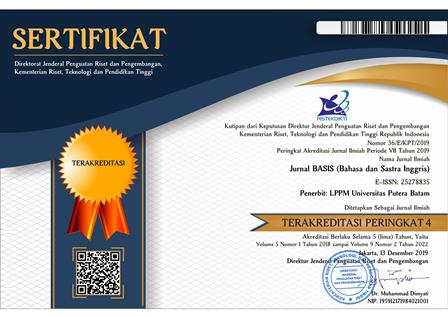EFL LEARNERS’ PHONOLOGICAL INTERFERENCE OF ENGLISH ARTICULATION
DOI:
https://doi.org/10.33884/basisupb.v6i2.1415Keywords:
British English Received Pronunciation, consonants, mispronunciation, vowelsAbstract
This research investigated the mispronunciation of Putera Batam University EFL learners by adapting the standard of Received Pronunciation (RP) and the factors of English vowels and consonants mispronunciation. This descriptive qualitative research applied observational method with participatory technique in collecting data, and articulatory identity method in analyzing the data. The English mispronunciation was found in the EFL learners’ English pronunciation. The consonant sounds /ð/, /θ/, /th/, /z/, /r/, /ʃ/, /ʧ/, /ʤ/, /nj/, and consonant-closed syllable sound of /k/ were pronounced incorrectly. The consonant sound /ð/ was pronounced as /d/, /θ/ as /t/, /th/ as /t/, /z/as /ɉ/, /r/ as /ɾ/, /ʃ/ as /s/, /ʧ/ as /s/, /ʤ/ as /d/, and /nj/ is pronounced as /ɲ/. Consonant-closed syllable sound of /k/ is articulated as /Ɂ/. The vowel sounds /ə/ and /æ/ were pronounced incorrectly as /e/ and the diphthong sound /eɪ/ were pronounced incorrectly as /e/. These mispronunciation phenomena were caused by some factors based on their background. The factors were; the mother tongue interference (native language), the differences between Indonesian and English sound systems (phonetic ability), the educational background, and the environmental background (amount of exposure).
References
Ambalegin, & Arianto, T. (2018). English vowels and consonants mispronunciation of the seventh president of Republic of Indonesia in his official English speeches and its influencing factors. Langauge Literacy , Journal of Linguistics, Literature, and Language Teaching, 2(2), 113–128. https://doi.org/http://dx.doi.org/10.30743/ll.v2i2.678
Ambalegin, & Arianto, T. (2019). A phonology-based study: English pronunciation inconsistency. In The 2nd Annual International Conference on Language and Literature (AICLL 2019) (pp. 106–124). Medan: KnE Social Sciences. https://doi.org/https://doi.org/10.18502/kss.v3i19.4834
Ambalegin, Suhardianto, & Kaprawi, N. (2017). Obstacles facing learners in speaking English: Non-English teachers’ perspective, Putra Batam School. Pertanika Journal Social Sciences & Humanities, 25(1), 122.
Ambalegin, & Suryani, M. S. (2018). Mother tongue affecting the English vowel pronounciation of Batak Toba adults. In AICLL The 1st Annual International Conference on Language and Literature (pp. 66, 80). Medan: KnE Social Sciences & Humanities. https://doi.org/10.18502/kss.v3i4.1920
Brown, H. D. (2007). Teaching by principles: An interactive approach to langauge pedagogy (3rd ed.). San Francisco, USA: Pearson Longman.
Carter, R., & Nunan, D. (2001). The Cambridge to teaching English to speakers of other languages (1st ed.). New York: Cambridge University Press.
Celce-Murcia, M. (2001). Teaching English as a second or foreign language (3rd ed.). United State of America: Thomson Learning.
Creswell, J. W. (2012). Educational research; planning, conducting, and evaluating quantitative qualitative research (4th ed.). Boston: Pearson Education Inc.
Finegan, E. (2015). Language; Its structure and use (7th ed.). Stamford: Cengage Learning.
Gilakjani, A. P. (2016). English pronunciation instruction: A literature review. International Journal of Research in English Education, 1(1), 2. Retrieved from www.ijreeonline.com
Hakim, M. A. R. (2012). An analysis of phonetics b , d , g , j , ʤ and ð into English pronunciation for Java students ( A study on Java students at English Department on STAIN Bengkulu academic year 2011-2012). International Journal of Humanities and Social Science, 2(20), 244, 256. Retrieved from www.ijhssnet.com
Kelly, G. (2004). How to teach pronunciation. England: Pearson Education Limited. Retrieved from www.longman.com
Kenworthy, J. (1987). Teaching English pronunciation. New York: Longman.
Kieffer, M., & Lesaux, N. (2012). Effects of Academic Language Instruction on Relation and Syntactic Aspects of Morphological Awareness for Sixth Grades from Linguistically Diverse Background. The Elementary School Journal, 112(3), 45–57.
Lin, L.-C. (2014). Understanding pronunciation variations facing ESL students. International Journal of Humanities and Social Science, 4(5), 16–20. https://doi.org/10.30845/ijhss
Low, E. L. (2015). Pronunciation for English as an international language (1st ed.). New York: Routledge Publishers.
Maiza, N. E. (2014). Pronunciation and comprehension of oral English in the English as a foreign language class: Key aspects, students’ perceptions and proposals. Journal of Language Teaching and Research, 5(2), 262–273. https://doi.org/104304/jltr 52262-273
McMahon, A. (2002). An introduction to English phonology. Edinburgh: Edinburgh Universiy Press. Retrieved from https://doi.org/10.1159/000328775
Nagy, W. ., Berninger, V. ., & Abbott, R. . (2008). Contributions of Morphology Beyond Phonology to Literacy Outcomes of Upper Elementary and Middle-School Students. Journal of Educational Psychology, 98(4), 134–147.
Odden, D. (2005). Introducing phonology. New York: Cambridge University Press.
Okeke, N. U. (2008). Spelling and phonetic inconsistencies in English: A problem for learners of English as a foreign/second language. African Research Review, 2(1), 64–83.
Roach, P. (2012). English phonetics and phonology; A practical course (4th ed.). Cambridge, UK: Cambridge University Press.
Subandowo, D. (2017). The language interference in English speaking ability for Efl learners. International Seminar on English Language and Teaching, 205–206. Retrieved from ejournal.unp.ac.id/index.php/selt/article/view/8005
Sudaryanto. (2015). Metode dan aneka teknik analisis bahasa. Yogyakarta: Duta Wacana University Press.
Yule, G. (2014). The study of language (5th ed.). New York: Cambridge University Press.
Downloads
Published
Issue
Section
License

















